Hello readers! In this post, we’ll discuss the different types of fasteners and their applications using illustrations.
Fasteners are crucial to the creation of many different objects. Imagine you regularly complete DIY projects. In that case, there is a strong likelihood that you used fasteners to complete your task. They assist in holding parts together while preventing excessive vibration and pressure.
There are many types of fasteners. Also, there is a good deal of variability among the different types. This article will go over the various types of fasteners and their subtypes. Additionally, we’ll provide you with crucial advice to aid in choosing the appropriate fastener for your project.
Let’s define fasteners first before getting into the specifics.
What are Fasteners?
Fastener is a general term that covers a wide range of tools. These tools, which include nuts, bolts, screws, and other items, all have the same purpose. The purpose is to make it possible for objects to adhere mechanically. Fasteners are mechanical components that hold objects together or in place.
You could argue that glue can successfully carry out this task. As glue does not qualify as a fastener, what is it then? This forces us to go beyond the original definition. Fasteners known as hardware serve as a mechanical anchor for holding objects together.
Fasteners are several parts of any machine whether it is big or small. These parts are joined in different ways according to their role and position in a machine.
Such holding devices as nuts, bolts, screws, keys, washers, rivets, anchors, studs, inserts, rings, and pins are called fasteners. The process of holding together the different parts of a machine is called fastening. Fastening can be of three kinds.
- Temporary fastening
- Semi-permanent fastening
- Permanent fastening
1. Temporary Fastening
When parts of a machine are joined in such a way that these can be disjointed or joined again easily, it is called temporary fastening. There is no harm to the machine or its parts in temporary fastening.
In temporary fastening nuts, bolts, screws, lock pin, and washer are used. These things are called fasteners. The main temporary has been explained later in the article.
2. Semi-permanent Fastening
In a semi-permanent fastening method, the fastening may be destroyed but not work. It is used when the joints have had little chance of re-opening. Such as soldering, and riveting.
3. Permanent Fastening
They are single-use fasteners designed to be a permanent joint between two materials or parts. When a permanent fastener is used, the parts will never come apart. Example of permanent fasteners is rivets, welding, soldering, and brazing.
Read Also: Types of Springs and Their Applications [Explained]
Types of Fasteners
Following are the types of fasteners:
- Nuts
- Bolts
- Screws
- Washers
- Key and key-ways
- Studs
- Rivets
- Anchors
- Nails
- Inserts
- Retaining rings
- Clevis Pins and cotter pins
#1 Nuts
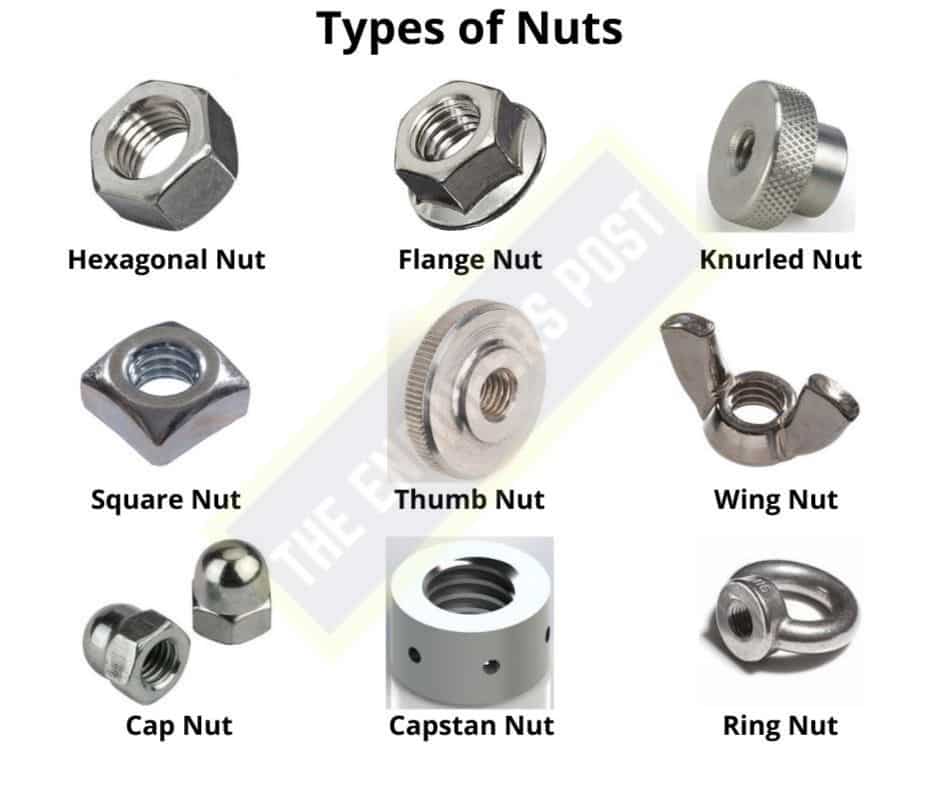
It is a small block of metal or other material commonly square or hexagonal in shape. It has internal threads to receive a bolt. Bolts are mostly used with the help of nuts. According to their working position.
They are available in a variety of types and designs that enable them to fit into a range of bolt shapes. The following are some of the various nut types:
#1 Cap Nut
Their closed ends have a dome-like appearance. This makes it easier to maintain the protection of the bolt-nut connection. Additionally, it guarantees that your work is finished well.
#2 Hexagonal Nut
Hex nuts are fasteners that have internal threading and a hexagonal shape. Their center is hollow and ring-shaped. Hex nuts, however, have a six-sided hexagonal exterior.
#3 Flange Nut
It is a nut that does not require a washer because of its expanded base.
#4 Wing Nut
A wingnut, also known as a butterfly nut, is a type of nut with two sizable metal “wings,” one on each side, making it simple to tighten and loosen by hand without the use of any tools.
#5 Thumb Nut
It is a nut with an exterior surface that has been knurled and is also known as a knurled nut. This makes hand tightening easier or fastens the nut to a handle or cover.
Read Also: Check out the list of 20 Types of Nuts and Bolts.
#2 Bolts
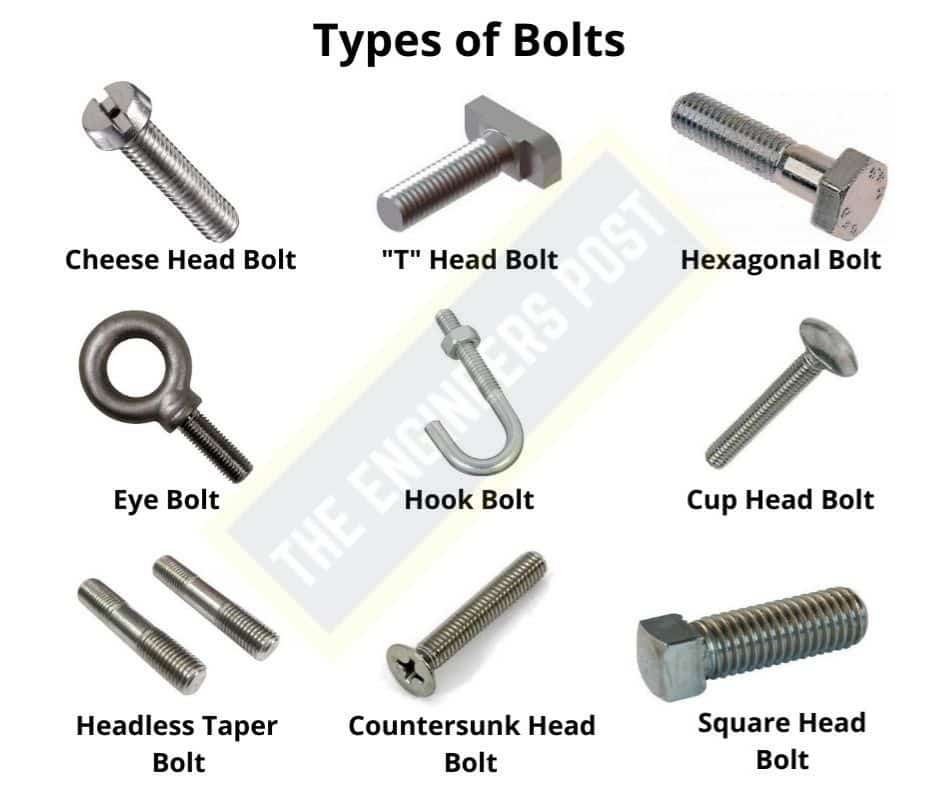
This is one of the widely used fasteners. Bolt is made from a thin rod of metal. On its upper side, different types of heads are made to fix them. On the remaining part or a part of it, there are threads. From this side, it can be fixed in a job or a nut can be fitted figure shows a nut and a bolt.
Bolts come in a variety of types and are used in many applications. Here are a few of the most well-liked ones:
#1 Hexagonal Bolt
Hex bolts are a specific type of threaded bolt defined by their head’s six-sided hexagonal shape. Hex bolts are suitable for use in a variety of applications, typically in machinery and construction, and can be fully or partially threaded.
#2 Cheese Head Bolt
Cheese head slotted screws have cylinder-shaped sides, a flat top disc, and a flat bearing surface. They can be identified by the type of head they have, which has a slot drive and a head height that is roughly half of its diameter.
#3 “T” Head Bolt
T-Head bolts also referred to as Hammer-Head bolts, have a variety of uses, including fastening lift guide rails.
#4 Eye Bolt
Bolts with loops on one end are known as eye bolts. They are employed to firmly fasten a securing eye to a structure, allowing ropes or cables to be tied to it.
#5 Square Bolt
Similar to hex cap screws, square head bolts have a square head with four sides as opposed to a hexagonal head with six sides.
#6 Headless Taper Bolt
This is applied to substantial marine shaft couplings. It lacks a head and has a tapered shank.
#7 Countersunk Head Bolt
A countersunk screw, also referred to as a flat-heat screw, is a particular type of screw that is intended to rest flush with the object or surface into which it is inserted.
Read Also: List of 30 Types of Pliers with How To Use Guide? with [Pictures]
#3 Screws
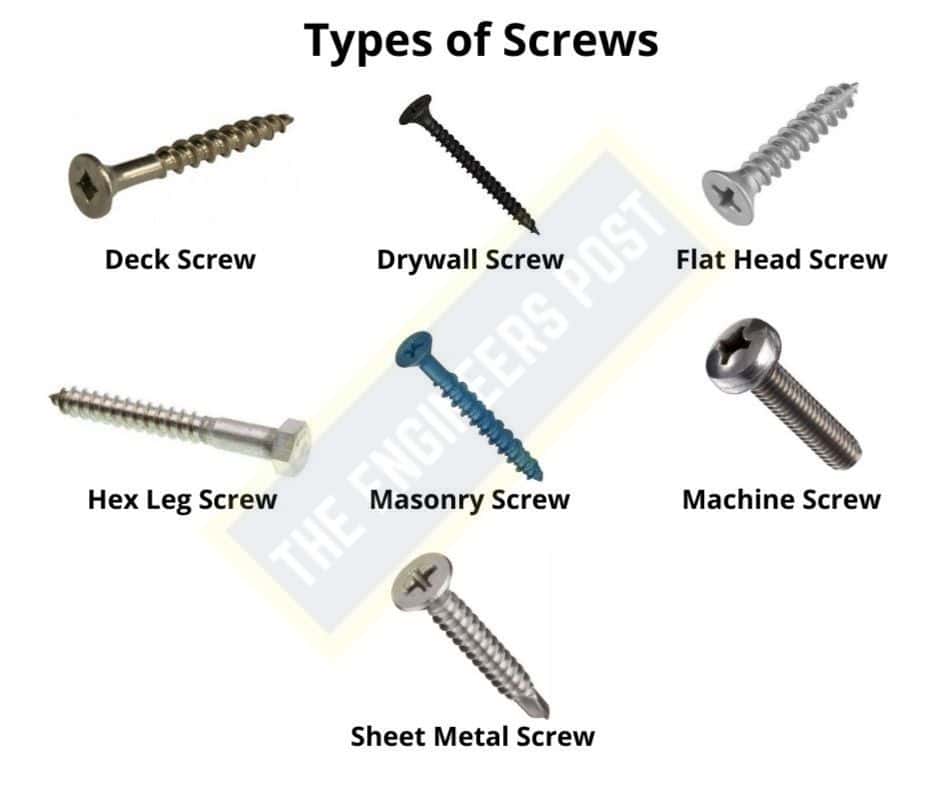
Screws are used for joining different parts of machines. Different types of threads are cut on screws. A screw may be considered a helix wound around a cylinder.
Their diameter is comparatively smaller than bolts. Their diameter is up to about 1/4″. The heads of the screws are of different types. The screw is mainly divided into four parts.
#1 Deck Screw
Deck screws can be used to install rails, construct framing, and fasten boards to decking.
#2 Drywall Screw
Drywall screws are used to secure the wallboard to the studs. However, their toothy threads and trumpet-shaped heads make them appealing for other tasks.
#3 Flat Head Screw
Known also as countersunk screws, flat head screws are cylindrical in shape, with a flat outer surface and a tapering inner surface.
#4 Hex Lag Screw
Hex lag screws are fasteners with a coarse thread that has a sharp tip and a hexagonal head. Hex lag screws are identified by their hexagonal heads.
#5 Masonry Screw
Concrete masonry screws are used to secure items to brickwork, concrete, stone, and other hard surfaces. They are made of robust steel and are specifically designed to fix items effectively into hard materials.
#6 Machine Screw
Machine screws are typically made with finer, more accurate threads than other types of fasteners. They are typically used with a pre-drilled interior tapped hole or a nut.
Read Also: Screw Thread Terminology.
#4 Washers
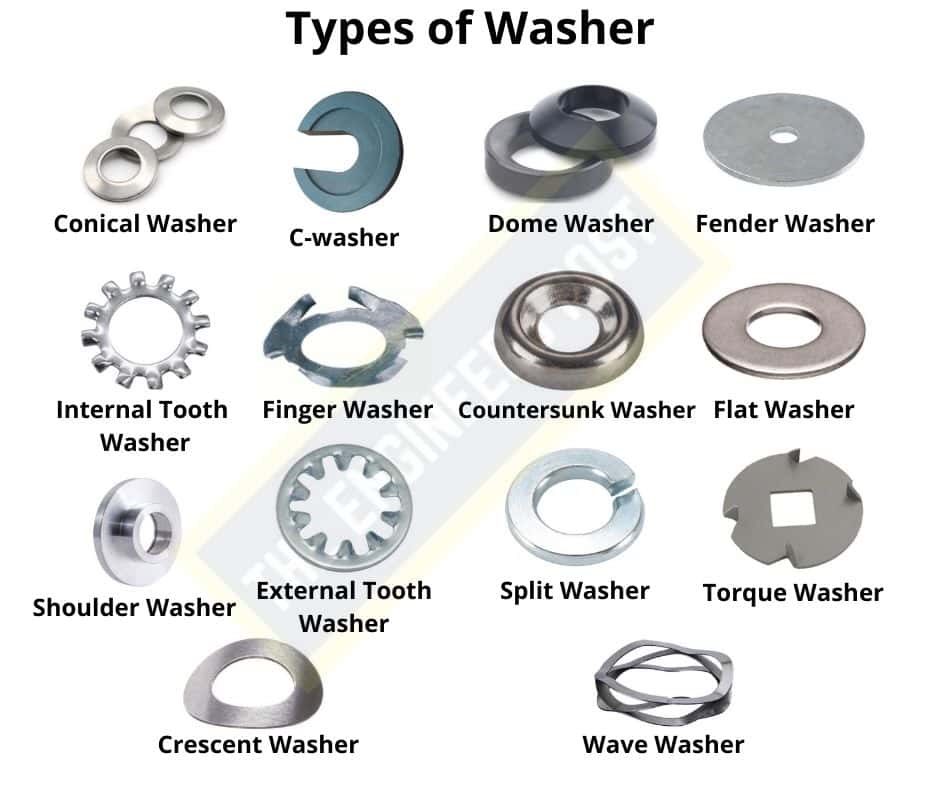
Its shape is like a round ring. Before tightening the nut and bolt, it is fitted on a stud or bolt. It is used to ensure the tightness of a joint, screw, etc., and make it easier to unscrew the nut and bolt and keep their threads secure.
Even if the diameter of the bolt in which the bolt is to be fitted is larger than the diameter of the bolt, with the washer’s help and the nut, the bolt can be tightened easily.
#1 Conical Washer
A conical washer is also known as a Belleville washer and in some cases a coned-disc spring. It is a conical shell that can be loaded statically or dynamically along its axis.
#2 Dome Washer
Dome washers have a high load capacity while having a low overall deflection. Dome washers, also known as semi-spherical washers, have the shape of a truncated sphere.
#3 Fender Washer
A flat washer with an outer diameter that is larger than its center hole is known as a fender washer. In comparison to most flat washers, they are constructed from a thinner gauge of metal and are intended to distribute the load on thin sheet metal.
#4 Internal Tooth Washer
The teeth of an internal tooth lock washer project radially inward to bite into the bearing surface. The purpose of the internal tooth lock washer is to stop a nut or bolt head from losing due to the strut action created by the teeth.
#5 External Tooth Washer
To secure nuts, external tooth lock washers are used. External tooth washers, also called Star Lock Washers, are serrated washers that exert pressure on the installation surface with their teeth.
#6 Shoulder Washer
A shoulder washer protects fasteners, wires, and shafts from moisture and electricity. It has an attached sleeve, or bushing, at one end that resembles a standard flat washer on the other.
#7 Countersunk Washer
The bowl-shaped countersunk washers ensure that flat or oval countersunk head screws lie flush with the surface and provide a professional appearance.
#8 Split Ring Washer
Split ring washers employ friction to stop bolted joints from becoming loose. They have an intricately twisted and split ring with two rough edges.
#9 Split Washer
The crescent spring washer is also called a curved spring washer. The shape of a crescent washer is similar to a flat washer that has been slightly curved to apply minimal pressure and maintain flexibility.
#10 Torque Washer
In order to prevent bolts from losing over time, torque washers are designed as follows: The bolt is anchored in place by four prongs that pierce the material.
Read Also: 14 Types of Washers and How They Used?
#5 Key and Key-ways
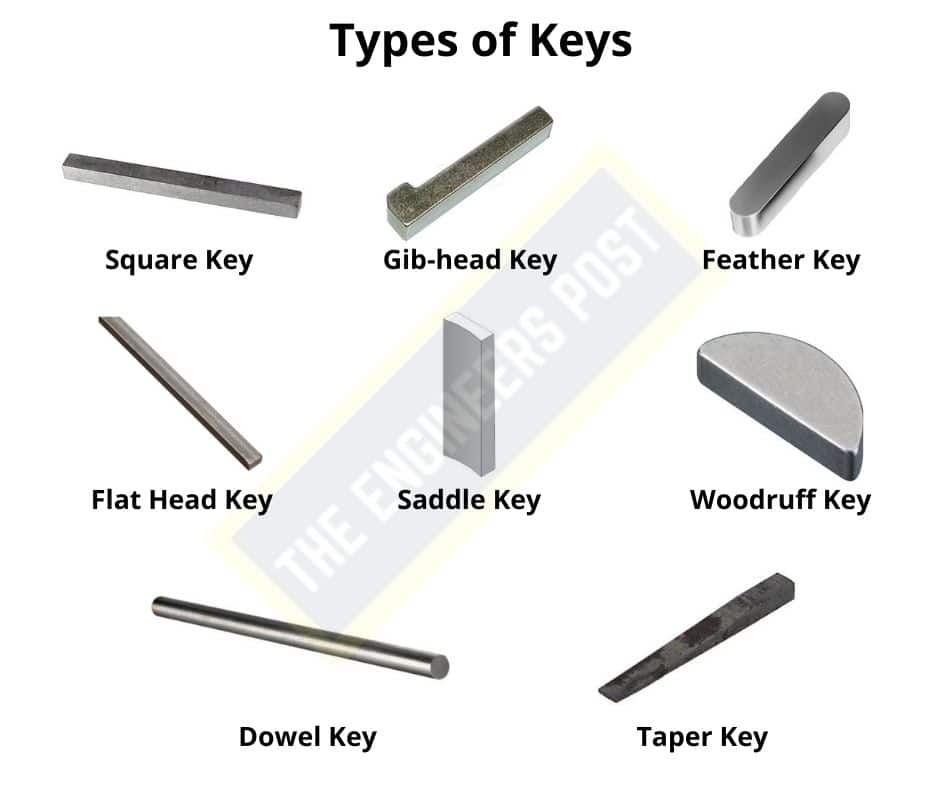
A key is a machine element that connects a rotating machine element to a shaft and enables torque transmission. The key helps to prevent relative motion between two parts. As the below figure shows, the shaft must have a keyway to fit the key on it.
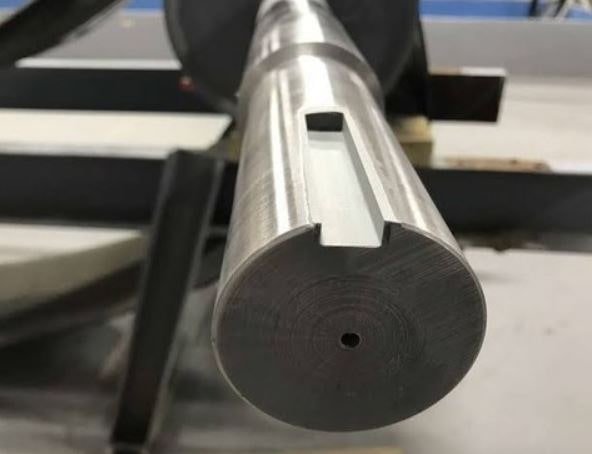
With the help of a key, the gear or pulley cannot move on their shaft but the shaft and gear or pulley move together as one unit. A key is inserted between a shaft and a wheel in the keyway.
This makes the shaft and gear or pulley (or we can use the term “wheel”) one unit. Keys are generally made of good quality steel in order to withstand (bear) the stresses.
#1 Square Key
Square keys are used for smaller shafts, while rectangular-faced keys are used for shaft diameters greater than 6.5 in (170 mm) or when the mating hub’s wall thickness is an issue.
#2 Gib-head Key
Gib Head Keys are machine keys with a protruded end that resembles the end of a gib and acts as a stop mechanism on a rotating shaft.
#3 Feather Key
Similar to the parallel key, feather keys are machined to extremely close length tolerances and have radii on both ends.
#4 Saddle Key
It is a concave key that fits into a keyway in the secured member and grips the machine shaft with friction (compare flat key, sunk key) in order to secure a member to a machine shaft.
#5 Woodruff Key
Woodruff keys are simply semi-circular discs that are used to attach machine parts to rotating shafts and spindles. They serve to prevent the movement of gears or other machine components apart from the rotating shaft.
#6 Dowel Key
Dowels are cylindrical rods that are typically made of metal, plastic, or wood. A dowel is known as a dowel rod in its initial manufactured form.
#7 Taper Key
The keyway in the hub has the same taper as the tapered key. The taper’s functions include holding the key in place and securely fastening the shaft to the hub without the use of a set screw.
#6 Studs
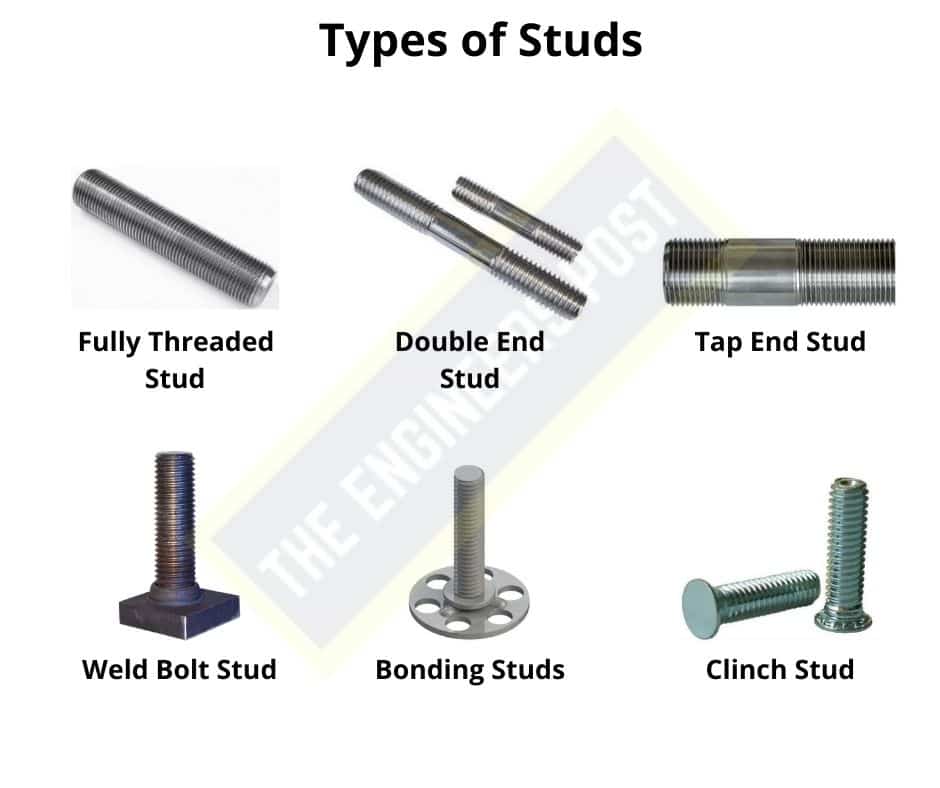
It can be termed a headless bolt. A stud is a relatively long rod that has threads on both ends, the threads may extend along the complete length of the rod. First, the stud is tightened in the hole of the part to be joined with it and then a nut is tightened on it.
Its main advantage is that we can separate the upper part simply by opening the nut while keeping the lower part intact. These studies are mainly of the three types.
In the round stud, the middle portion is also round. In a square stud, the middle portion is kept square. The third type is a collar made at a little distance from the center. It is often used in the cylinder head in automobiles.
#1 Fully Threaded Stud
These full screws, which are threaded rods without heads, are also known as long screws or stud bolts. A bolt with thread on both sides is referred to as a stud bolt.
#2 Double-Ended Stud
Double End Studs are also known as tap-end studs or double-end rods. These fasteners are threaded, meaning they have a thread on both ends and an unthreaded area in the middle.
#3 Weld Bolt Stud
Welded fasteners are an excellent choice for establishing a super-strong and permanent connection between steel and the fastener.
#4 Bonding Studs
Bonded Studs are robust structural components that offer significant tensile and shear strength. They can be bonded to either the bottom or top surface of the base plate.
#5 Clinch Stud
A clinch stud is a type of fastener intended for use with thin materials, such as sheet metal panels. It has a head on one end of a stud or shaft and a string of prongs or fingers on the other.
#7 Rivets
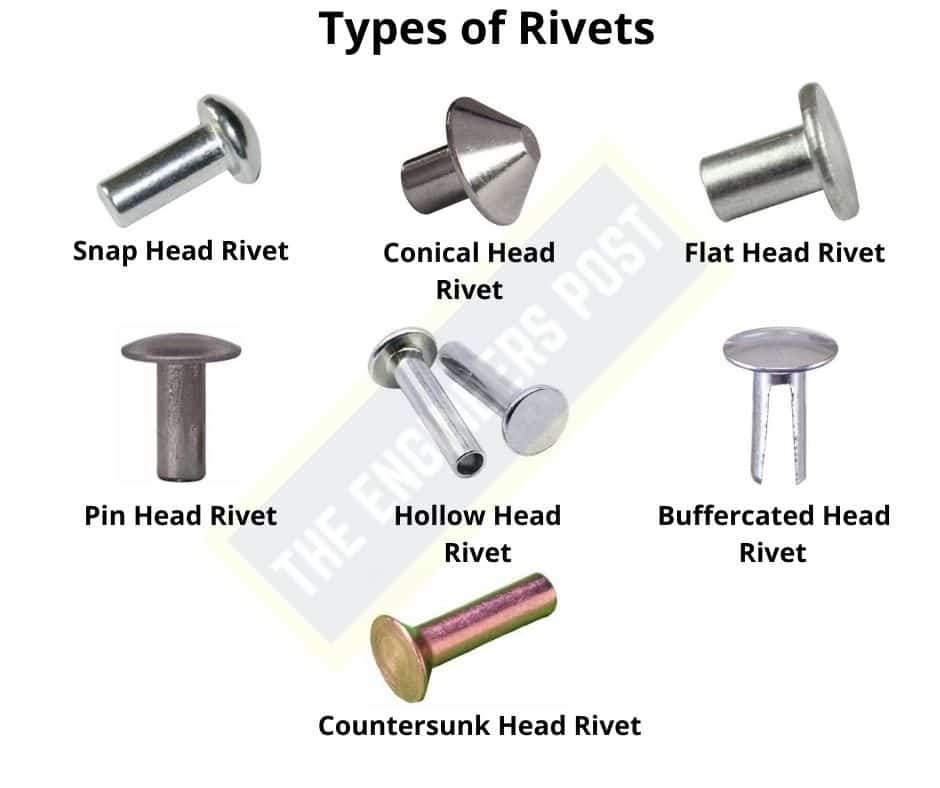
In order to joint the jobs made of sheets or plates permanently these rivets are used. In the boiler and sheet metal work, it is used for making trunks and buckets.
Rivets are usually made of mild steel but sometimes they are also made of brass, copper and aluminum, etc. The rivet consists of only three parts, which are the head, shank or body, and tail.
Read Also: Different types of rivets [complete guide].
#8 Anchors
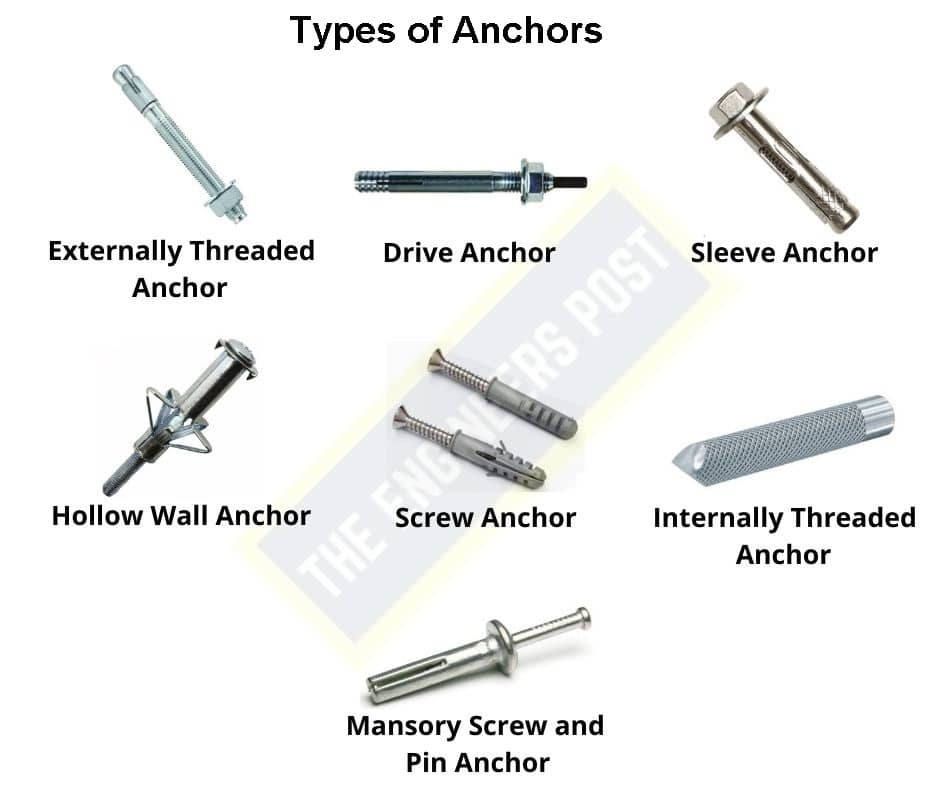
Anchors are types of fasteners, their function is similar to the anchor of a boat, which inserts itself into the seabed to prevent the ship from moving. Typically, it is used to attach something to a material such as drywall or concrete. They insert themselves into the material and keep the object you are affixing.
#9 Nails
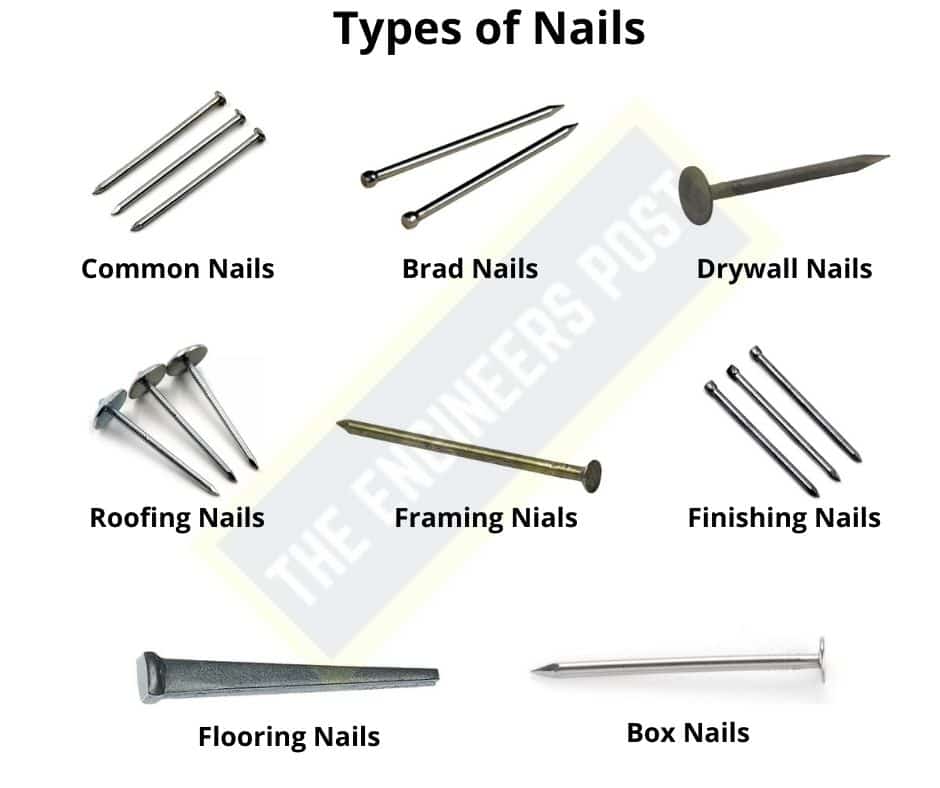
It is a small metal spike with a wide flat head, which is pushed into the wood to hold things together or used as a hook. Nails have been used since the early years and they have now become a household item.
You can easily understand the difference between a screw and a nail because a nail does not have threading on its body. The different types of nails take their names from their applications, which can help you find the right type of nail for the job you are looking for.
Read Also: What are the Types of Nail Guns? When and How to Use?
#10 Inserts
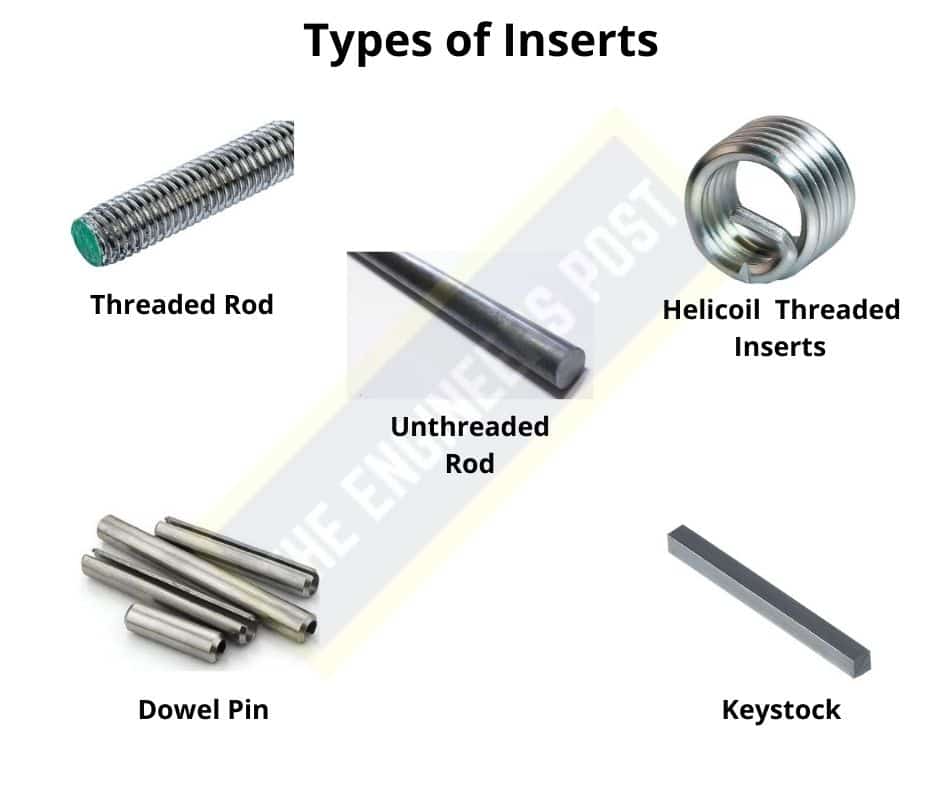
These are the type of strong threads and are usually cylindrical in shape also known as thread bushings. They are used for many applications such as securing long-lasting connections between different materials or repairing stripped threads.
The typical application of this fastener is to distribute loads from the smaller diameter of the screw to the larger diameter of the insert.
#11 Retaining Rings
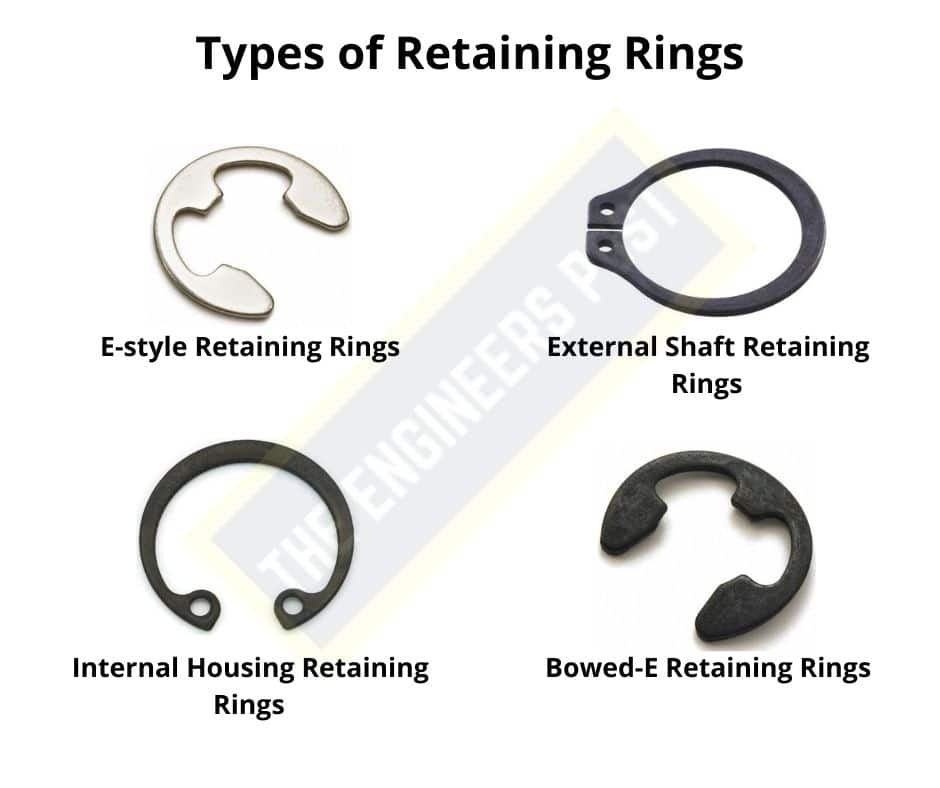
The retaining rings are types of fasteners used to hold shafts or assemblies in place. They are usually designed in different shapes. They are used in many applications in machinery.
An example of a retaining ring is used to hold the latch pin of an IC engine piston. In addition, it is also used to hold the assembly together in the high-pressure fuel pump of a diesel generator. Most retaining rings are one-time use and replaced when machinery is repaired but some can be reused.
#12 Clevis Pins and Cotter Pins
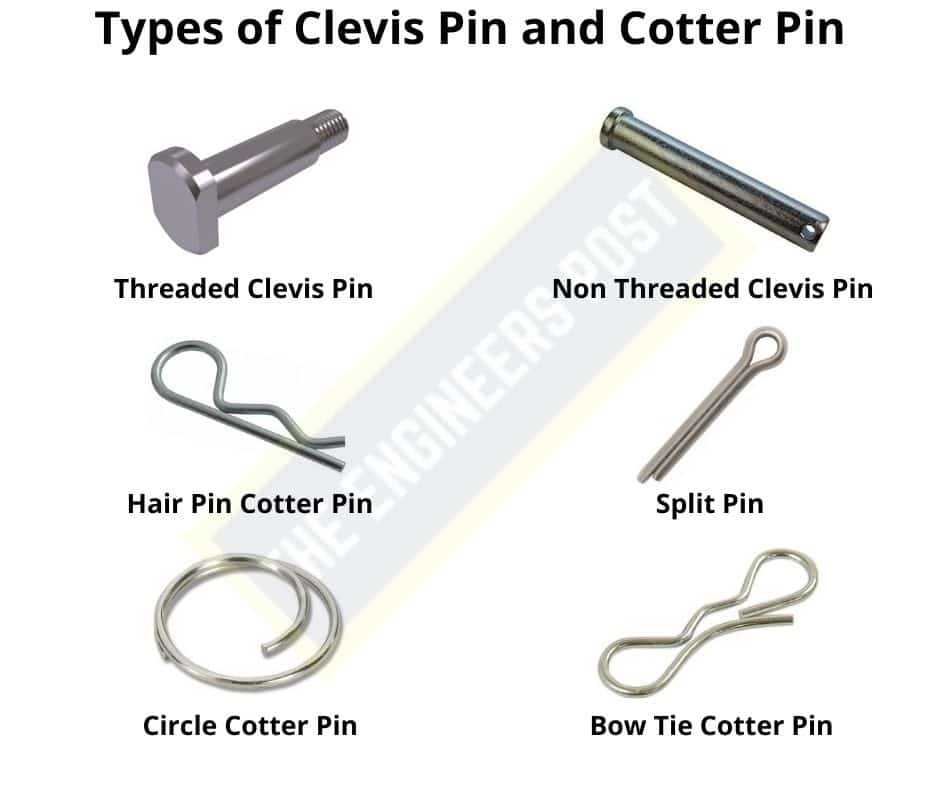
These are types of fasteners, which are further manufactured from steel pins or with a cylindrical shaft. These have a hole in the shaft into which a cotter pin is inserted and bent to act as a staple. These are used to keep the components of machines in precise position or alignment.
Advantages of Fasteners
The following are the advantages of fasteners:
- Using fasteners will reduce the weight of the component.
- They have the ability to achieve high-strength steel up to a tensile strength of 1500 MPa.
- Fasteners require minimal space within the appliance.
- The equipment maintenance of fasteners is easy and simple.
- They are easy and simple to install in every working place.
Disadvantages of Fasteners
The following are the disadvantages of Fasteners:
- If you are using fasteners, this will increase the weight of the component.
- They usually require holes to fit a fastener that weakens the components.
- They are able to work at specific points in all types of loads, which will lead to fatigue.
- Once fastened, it is difficult to fasten again.
- They often lead to corrosion.
Wrapping It Up
With the wide variety of fasteners available today, it becomes challenging to choose the right fastener for your application. We have almost covered the different types of fasteners and their uses in this article.
If you still have any questions about “types of fasteners” you can ask in the comments I’ll respond to you. If you like this article then share it with your friends.
Subscribe to our newsletter.
Download PDF of this article:
Read more in our blog:
Yes but what are those cheapo fasteners used especially on toys today called??? Typically they look like a washer (sometimes with radial slots opening toward the center) or like a flat top hat with a brim. Often they are slid onto the toy’s axle but cannot be easily slid back off – thus holding on the wheels or hiding a sharp end.
Those fasteners are called “push nuts” or “axle caps.” They are designed to be easily pushed on but not easily removed.
not sure if you are still about ,can you explain to me what a plow bolt is
Sure! A plow bolt is a type of fastener with a flat, countersunk head, typically used in heavy equipment.
Wanderful
Thank you.
Very big help. glad i found your website. Keep up the good work.
Thanks, will do.
Awesome informations
Thanks for reading.
Thanks for this good work
You’re welcome.
Love your works, please I need more again than this, thanks
Glad you liked it.
Thanks
You’re welcome.